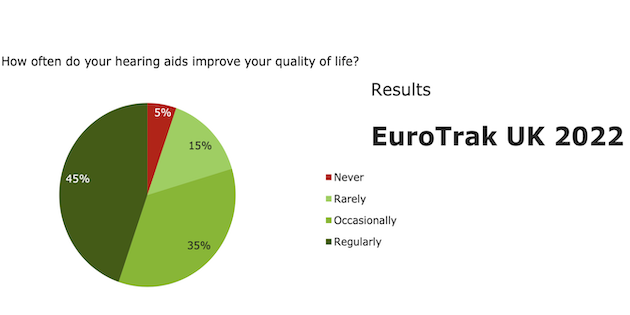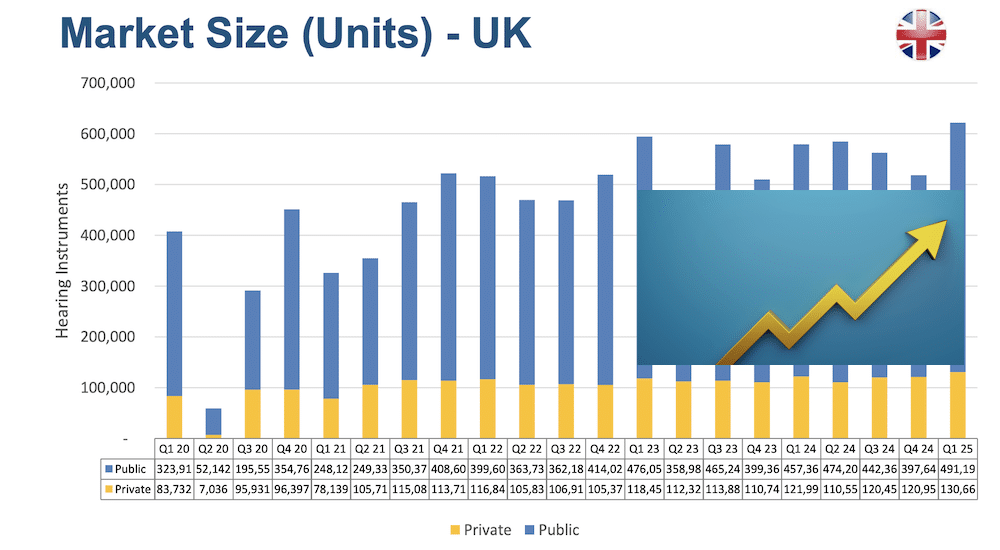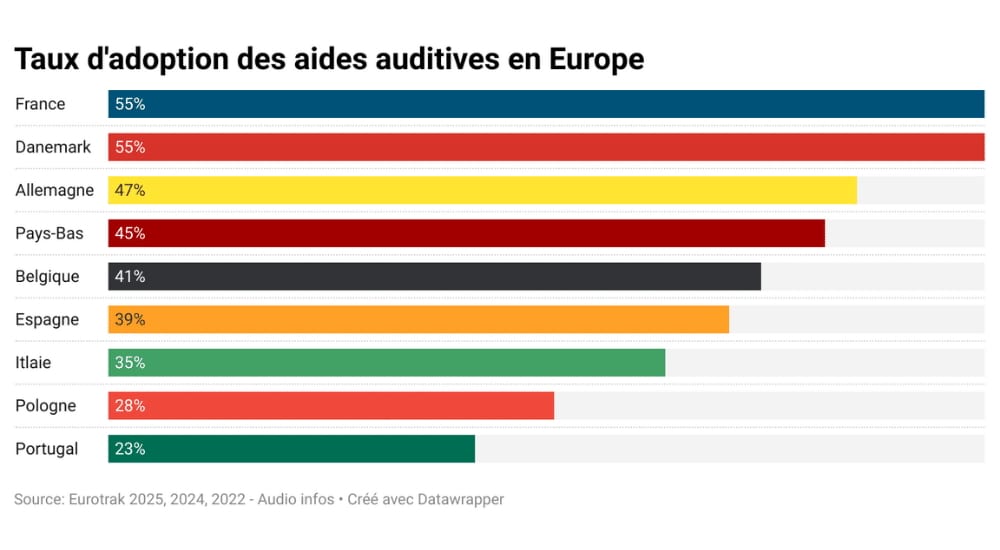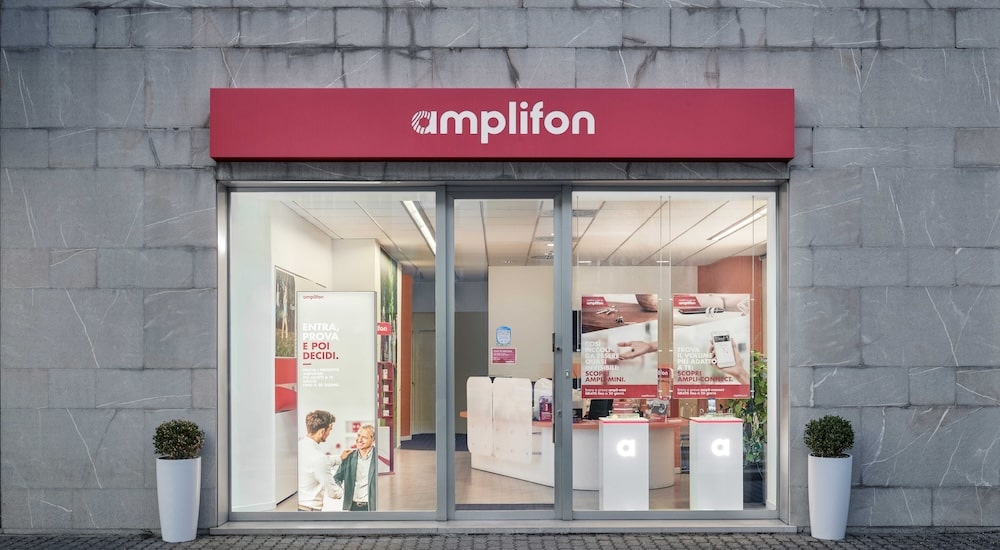95% of hearing aid owners declare that their hearing aids improve their quality of life at least sometimes - just one revealing datum from the 2022 UK EuroTrak survey
The latest reveals from the pivotal EuroTrak UK survey show positives on hearing aids - increased adoption, better quality of sleep, brand awareness rise, perceived quality of life improvement - but there is still work to be done.

For manufacturers and professionals alike, data from the so-called EuroTrak survey informs decisions, fuels concerns, provides tools for communication down to the professional (even to the end user), and leads into further research projects… And a whole lot more.
The European Hearing Instrument Manufacturers Association (EHIMA) has this month launched the results from the latest survey of the hearing aid scene in the UK: EuroTrak UK 2022. The last set of data came out two years before the pandemic, in 2018.
What the latest data holds has been collated and analysed by EHIMA and, importantly, the company that developed the EuroTrak concept, Anovum Zurich, which designs the questionnare, conducts the fieldwork, analyses the data and puts together the final presentation.
EuroTrak survey sample numbers
For the first-step screening interviews, the representative sample was n=15,479 people based on census data; the step-two target population interviews used a sample of n=703 hearing aid owners and n=617 hearing impaired non-owners.
So, what’s in EuroTrak UK 2022?
PW Philip Stores studies the wealth of data delivered through the EuroTrak UK 2022 hearing aid market survey
With the help of comments from Philip Stores, Managing Director of WS Audiology (UK and Ireland), Audiology Worldnews highlights a hatful of the individual stats from the 2022 results.
Hearing aid adoption rate: 53% of hearing impaired have hearing aid(s), 62% of them have binaural treatment
Philip Stores (PS): We have a 53% adoption rate but actually what that shows is that 47% of people who actually state they have a hearing loss have actually done nothing about their hearing and not actually sought any help. If we look at it in another way, those with the highest level of hearing loss have a nearly 80% adoption rate. So this is not unsurprising, but I think we’ve got more work to be done if we look at people with a mild moderate hearing loss.
 EHIMA/Anovum
EHIMA/Anovum
The route to the hearing aid.
- 70% of the hearing impaired discussed hearing loss with an ENT doctor or family doctor.
- 58% got hearing aids recommended from the ENT or family doctor (drop out rate=30% / 2018: 28%).
- 51% of the GP consultations referred to an ENT, 43% to an Audiologist, 20% to get hearing aids. 9% recommended no action.
- 42% of ENT consultations referred to an Audiologist, 52% recommended to get a hearing aid, 18% recommended no action.
PS: So the drop-out rate for those who say they have a hearing loss to actually doing something about it in consulting a GP has a drop-out of 30%. This has slightly increased since 2018 and I believe this is probably down to the fact that we’ve had COVID and access to getting into a GP has been more challenging. If we look at the drop-out rate for those seeking help from their GP the drop-out rate has improved, which is actually very very positive.
Work competitiveness: 90% of the working hearing aid owners state their hearing aid(s) are useful on their job.
PS: Very encouraging to see that the difference between a hearing job performance enjoyment is clear. I think we still got some work to do in this area to improve overall scoring. I think we find that most workplaces do offer challenging listening situations and maybe a focus on more use of accessories there would benefit hearing aid users.
General health problems: Quality of sleep seems to improve if hearing impaired use hearing aids
PS: Hearing aid users have a significantly better sleep compared to individuals that have not sought assistance for their hearing loss, which is a major, major thing that we should promote when we’re speaking to potential end users.
 EHIMA/Anovum
EHIMA/Anovum
41% of the population in UK have never heard of Cochlear Implants. 30% of the HA owners with severe/profound HL have been informed about CIs by a medical professional.
PS: I think as an industry we can build on the awareness even better and obviously look at promoting what the referral criteria is for people that could be a good candidate for a cochlear implant.
 EHIMA/Anovum
EHIMA/Anovum
66% of all HA owners think they should have gotten their HAs sooner! Main reason is missing out on social life.
PS: When we look at the number of people who own hearing AIDS, we see that 66% of people would have got their hearing aid a lot earlier. So it’s a big, big piece of work that we’ve been doing to communicate, to especially people who think this on the early onset of hearing AIDS, that people who’ve done something about the hearing aid have much higher quality of life and wish that they’d done something much sooner.
 EHIMA/Anovum
EHIMA/Anovum
On average, HAs are worn 8.1 hours a day
PS: If I actually take this data back to 2015 and to 2012, we actually see that wear time hasn’t increased significantly within the last ten years, which again is surprising given the advancement in technology and the better results that we see from the latest technology.
 EHIMA/Anovum
EHIMA/Anovum
NHS is the preferred place for obtaining hearing aids (both for owners and non owners).
PS: This is not great for us manufacturers, but actually probably is not surprising given that the highest volume of participants in this survey acquired a hearing aid through the NHS. I know, being an ex NHS audiologist, that in practice you don’t tend to talk about the brands of a hearing aid, so it’s not surprising. And in the private market I think there’s a lot of brand recognition, but also a lot of focuses not on the hearing instrument, but around the service provision and the aftercare that the end user would get.
 EHIMA/Anovum
EHIMA/Anovum
33% of today’s hearing aid owners are aware of their hearing aid brand (brand awareness has increased since 2018)
PS: I think the concerning thing that I saw out of this is that 30% didn’t know but couldn’t actually find out what type of hearing aid that they’re wearing given that most of our hearing aids actually have a brand or an identifaction mark on the side of them.
EHIMA/Anovum
22% of the HA owners use a hearing aid app, 65% of those are satisfied with it.
PS: I think that the majority of hearing AIDS now have some form of app available for them and overall usage is still pretty low at 22%. I think this could be down to potentially education of the audiologist but also some of the time constraints that we see in some of the clinics. What we’d like to see is this number increasing over time.
 EHIMA/Anovum
EHIMA/Anovum
8% of the HA owners have already used remote fitting, 17% have at least heard of it, 74% have never heard of it
PS: So we know that the overall usage of remote fitting is low, we know that it could offer benefits to end users and clinicians, certainly around simple fine tuning and ease of use. And I think my view is that we need to focus on this area as an industry, modernise our approach to some degree and kind of position ourselves for a more tech savvy generation that are coming through.
 EHIMA/Anovum
EHIMA/Anovum
85% of the hearing aid owners say their hearing aid works better than or as expected
Overall I’m taking from this that as an industry we’re doing a pretty good job. Could we improve? Of course we could. But I think the other side is getting the message out around the benefits that we see in the survey around the benefits of public opinion on hearing AIDS, but also the benefits of what people get in their daily lifestyle.
 Factors influencing satisfaction with current HA: Sound quality/signal processing is most important for overall satisfaction with HA
Factors influencing satisfaction with current HA: Sound quality/signal processing is most important for overall satisfaction with HA
PS: So I think when we ask about the audiologist, the main influence was service and the quality of fitting and the after purchase period, which again is positive.
EHIMA/Anovum
67% of the hearing aid owners feel more confident moving in a city since wearing hearing aids
PS: Sixty-seven percent seems positive. But on the flip side to that when we look at 33% don’t feel more confident with their hearing when they’re out and about, I think highlights certainly to the manufacturers that there’s work to be done in this area
 EHIMA/Anovum
EHIMA/Anovum
Top 10 reasons for not having a hearing aid. 49% cite uncomfortability; 45% say hearing loss not severe enough; 43% say hearing aids do not work well enough in noisy situations; 41% cannot afford a hearing aid
PS: I think we need to work harder as an industry to dispel some of the myths and stigma around hearing AIDS. I personally don’t believe as an industry we always get the feedback that we see here from end users that are actually wearing hearing AIDS. I think it’s more the opposite, that people tend to think that for instance, they are more comfortable than they expected them to be. I think when we start looking at the hearing loss is not bad enough or hearing well enough in most situations, there I think we’re in the area of denial and lack of education about the early intervention and the benefits that that can give to end users. Interested to see affordability on here as well high up given that we have an NHS provision which is free at the point of delivery.
Source: EHIMA


 EHIMA/Anovum
EHIMA/Anovum
 EHIMA/Anovum
EHIMA/Anovum EHIMA/Anovum
EHIMA/Anovum EHIMA/Anovum
EHIMA/Anovum EHIMA/Anovum
EHIMA/Anovum EHIMA/Anovum
EHIMA/Anovum
 EHIMA/Anovum
EHIMA/Anovum EHIMA/Anovum
EHIMA/Anovum Factors influencing satisfaction with current HA: Sound quality/signal processing is most important for overall satisfaction with HA
Factors influencing satisfaction with current HA: Sound quality/signal processing is most important for overall satisfaction with HA
 EHIMA/Anovum
EHIMA/Anovum

